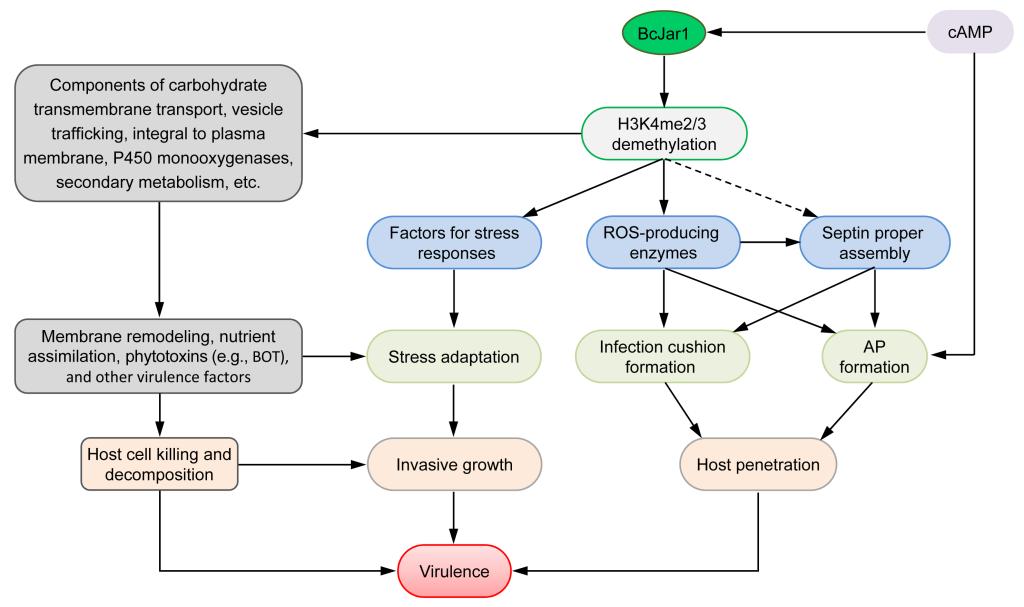In the process of pathogen-host interaction, histone post-translational modification plays an important role in pathogen infection and host defense. Demethylation is an important post-translational modification of histones, but for the pathogenic bacteria histone H3 lysine 4 (H3K4) demethylase JARID1 (Jar1)/KDM5 function and its regulation of pathogen development and pathogenic mechanism We know very little. Recently, the team of Professor Qingming Qin from the School of Plant Sciences of Jilin University published a research paper entitled "The H3K4 demethylase Jar1 orchestrates ROSproduction and expression of pathogenesis-related genes to facilitate Botrytis cinerea virulence" in New Phytologist. This paper systematically explained the function of the histone demethylase BcJar1 of Botrytis cinerea in the growth, development and pathogenesis of pathogenic bacteria, and analyzed that BcJar1 finely regulates the production of endogenous reactive oxygen species, the accumulation of septin and the septin protein. Correct assembly and expression of disease-related genes promote the regulatory mechanism of its virulence.

The study found that BcJar1 regulates the reproductive growth and pathogenic development of Botrytis cinerea. The BcJAR1 deletion mutant has reduced conidia yield, smaller spores, and only produces a few appressoriums but cannot form an infestation pad and loses pathogenicity. When wound inoculated, the mutant can produce lesions but expands slowly. Further research found that BcJar1 controls the formation of infestation mats by regulating the methylation level of H3K4me2/3; BcJar1 regulates the growth and development of Botrytis cinerea by regulating the production of endogenous ROS, such as spore germination, germ tube elongation, and infection structure ( Appressorium and infestation pad) are formed. Exogenous cyclic adenylate cAMP can partially restore the mutant's appressorium formation ability, but cannot restore its infective mat formation, indicating that cAMP can trigger the process of bypassing the defect in appressorium formation due to lack of histone demethylation. BcJar1 also directly or indirectly mediates the enrichment and assembly of the septin protein Septin to regulate the formation of infective structures. Transcriptome analysis showed that during the formation of the infestation pad, BcJar1 finely regulates the expression of genes related to ROS production, stress response, material transport, pathogenicity, toxin synthesis, Septin regulation, cell wall degradation, nutrient assimilation and other related genes. Differences in these genes The expression is consistent with the phenotypes of pathogen infection-related development, stress adaptation and pathogenicity. This study provides new insights for histone demethylation modification to regulate the pathogenicity of Botrytis cinerea.

H3K4 demethylation modification is ubiquitous in eukaryotic species and participates in a variety of physiological processes in organisms. In this study, with the histone demethylase BcJar1 of Botrytis cinerea as the entry point, the interaction between Botrytis cinerea and its host was used as a model system, and histone demethylation modification was studied in the regulation of growth and development and pathogenicity of Botrytis cinerea. The role of, provides a scientific basis for analyzing the molecular mechanism of gray mold pathogenicity and formulating new green prevention and control strategies for plant fungal diseases. In addition, this research helps to deepen our understanding of the pathogenic process of Botrytis cinerea, and provides usable targets for the development of new, efficient and environmentally friendly agents. BcJar1 is an evolutionary conserved protein. Through the functional study of BcJar1 in the development and pathogenicity of Botrytis cinerea, it can provide references for research in other fields, such as pathogen-host interaction, microbiology, biomedicine, infectious disease, Mycology, drugs/fungicides, etc.
Professor Qingming Qin’s research team is dedicated to the study of the developmental biology of plant and medical pathogens, pathogenic mechanism and host immunity. Related research results have been published in academic journals such as PLoS Pathogens, Environmental Microbiology, Cell Host & Microbe, Molecular Plant Pathology, New Phytologist, etc. on.
Doctoral student Hou Jie is the first author of the paper, and Professor Qin Qingming is the corresponding author. This research was funded by the National Natural Science Foundation of China, the overseas talent introduction plan of Jilin University, and the public welfare (agricultural) scientific research project.
